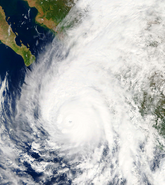An active 2024 North Atlantic hurricane season is likely according to numerous meteorological agencies and groups in their latest March and April seasonal tropical cyclone forecasts, with some even suggesting a hyperactive season is not out of the question.
With a month to go until the 2024 North Atlantic hurricane season officially gets underway on June 1, let’s take a look at what’s driving these early forecasts, how reliable they are, and what it might mean for the hurricane season.
North Atlantic: Record Warmth
As of late April 2024, sea surface temperatures (SSTs) are at or near record levels across most of the tropical and eastern portions of the subtropical North Atlantic.
The extent of the 26 degrees Celsius SST isotherm (which denotes areas supportive of tropical cyclone development) is across much of the tropical North Atlantic and Caribbean Sea, the largest at this time of year since 2010.
Furthermore, oceanic heat content (a measure of the thermal energy stored in a volume of water) is at record levels across much of the Main Development Region (MDR) and the Caribbean Sea. The North Atlantic basin looks primed.
With SSTs across the North Atlantic expected to remain at or near record levels throughout the coming months, including the peak months of the hurricane season between August and October, this favors a more active North Atlantic hurricane season owing to the increased energy available for cyclogenesis and intensification.
ENSO: La Niña is Coming…
Following the most recent El Niño phase that peaked through the late fall and winter of 2023–24, SSTs in the equatorial Pacific Ocean through the early part of 2024 have since trended toward their long-term average and are now deemed to be near-neutral (within ±0.5 degrees Celsius of the average).
The most recent El Niño–Southern Oscillation (ENSO) forecasts expect a transition into a La Niña (cool) phase by the fall. Some forecast models indicate this could arrive perhaps as soon as the early summer, which would coincide with the peak months of the North Atlantic’s hurricane season between August and October.
La Niña conditions in the equatorial Pacific typically result in a more active North Atlantic hurricane season owing to atmospheric teleconnections that typically decrease vertical wind shear and increase instability across the North Atlantic Basin, which generally promotes cyclogenesis and intensification.
However, there remains some uncertainty regarding the timing and magnitude of La Niña. Some seasonal forecasts are leaning towards a faster onset and arrival by the summer, while other forecast models expect cool-neutral conditions to persist for much of the summer before La Niña formally arrives later in the fall.
The timing of La Niña’s arrival and its magnitude will be crucial in determining just how active the hurricane season will be. The earlier the onset of La Niña in the equatorial Pacific, the longer the atmospheric teleconnections have to produce hurricane-conducive conditions in the North Atlantic.
Nevertheless, even if La Niña arrives later in the year and cool-neutral ENSO conditions are present for the majority of the hurricane season, the season may still yet be active owing to the hurricane-conducive sea surface temperatures present in the North Atlantic.
No Tug of War Between Factors in 2024
Last year’s hurricane season was characterized by a tug-of-war between these two factors – ENSO and sea surface temperatures (SSTs). In 2023, ENSO was in an El Niño phase, which marginally hindered activity, while record-warm SSTs in the North Atlantic promoted activity.
While 2023 concluded as an above-average season in terms of the number of named storms, the number of hurricanes and major hurricanes was climatologically average.
There is expected to be no such tug of war in 2024, with the warmer-than-average North Atlantic SSTs and ENSO’s transition to a La Niña phase both expected to promote hurricane activity this year.
Subseasonal Factors to Watch
While oceanic and atmospheric conditions are primed and look set to result in an active year, we cannot be as certain of the influence of several other sub-seasonal factors that can modulate tropical cyclone activity on a weekly or monthly basis and are difficult to forecast at seasonal timescales.
The North Atlantic oscillation (NAO) can influence the position and strength of the Bermuda-Azores High, which determines the large-scale synoptic patterns that influence the trajectory of individual storms in the basin.
While seasonal forecasts suggest the average location of this subtropical high will produce a preferential steering pattern across the tropical North Atlantic and Caribbean Sea towards the U.S. this summer, the path of individual storms will ultimately be dictated by the local synoptic patterns at the time of formation.
The advection of the dry and dusty Saharan air layer (SAL) from Western Africa over the North Atlantic between June and early fall can form a strong temperature inversion and introduce dry air across the basin that stabilizes the atmosphere and suppresses hurricane formation.
The Madden-Julian oscillation (MJO) is an intra-seasonal, eastward-propagating area of enhanced and suppressed tropical convection.
It is known to modulate tropical cyclone development and activity in the North Atlantic basin, especially for the strongest storms, by providing a large-scale environment that is favorable or unfavorable for development. The MJO cannot be skillfully predicted at seasonal timescales.
No Strangers to Active Seasons
Although only time will tell what unfolds this season, Moody’s RMS Event Response and the (re)insurance industry are no strangers to active hurricane seasons — seven of the last eight seasons (2016–23) were classified as above normal, with 2017 and 2020 designated as extremely active.
While long-term statistics indicate that the probability of a hurricane making landfall in the U.S. increases during more active seasons, there are notable exceptions to this tendency.
In 2010, 19 named storms and 12 hurricanes developed in the North Atlantic, but no hurricanes and only one tropical storm made landfall in the U.S.
So, while 2024 is looking likely to be an above-average season for the basin as a whole, this does not guarantee a higher number of systems may approach, threaten, or ultimately impact land.
However, we are reminded that it only takes one landfalling event to make a season costly or memorable.
Landfalls are ultimately decided by the trajectory and path of an individual tropical cyclone. This is dependent on both the broad-scale and local synoptic factors at the time of formation, which is not possible to skillfully forecast at seasonal timelines.
Whatever the final storm count in 2024, we remain committed to supporting our customers during active hurricane events. Last year, Idalia marked the fastest response by Moody’s RMS Event Response to a landfalling major U.S. hurricane.
Our industry loss estimate and associated suite of optimized post-landfall wind and surge modeling and accumulation information were released just five days after landfall, a testament to our event response workflow process enhancements and innovations over the last few years that have helped improve efficiency and reduce delivery timelines.
As a trusted partner, Moody’s RMS Event Response is once again ready to inform your critical business processes with reliable information during the year’s most impactful events.
Join Us at Exceedance 2024
Will you be at the Exceedance conference in Montreal on May 6–9? We have a dedicated Event Response workshop that will include a session discussing the latest North Atlantic hurricane season forecasts for 2024 and the key drivers of activity.
The workshop sessions will also explore the latest advancements to our event response offerings, and how integration of event response tools and data with the Intelligent Risk Platform is enabling innovative solutions to streamline your event response workflows.
You will also gain exclusive insights into how you can enhance your response to hurricane events with HWind, equipping you with the knowledge to prepare for the upcoming season.
In addition, we will delve into how high-definition (HD) models are enhancing our event response offering, discussing best practices for using these models from an event response perspective.
Find out more about the Exceedance agenda here.
Updated Forecasts to Come in May and July
The National Oceanic and Atmospheric Administration's (NOAA) Climate Prediction Center will release its official forecast in late May ahead of the season officially commencing on June 1, and most of the meteorological agencies and groups that have already issued activity forecasts will provide updated predictions.
Further updates to the forecast will come in late July before the North Atlantic enters its historically most active period between August and September.
Our annual Moody’s RMS Event Response Hurricane Season Outlook report will be issued in early June and will provide a full breakdown of these forecasts, a detailed look into the key factors driving this year’s forecasts, and a look at the historical performance of tropical cyclone seasonal activity forecasts.
The Moody’s RMS Event Response team is ensuring Moody’s RMS clients are well informed of global tropical cyclone activity with regular updates for clients on the Support Center.
Follow Moody’s RMS social media channels on X/Twitter and LinkedIn for updates.







